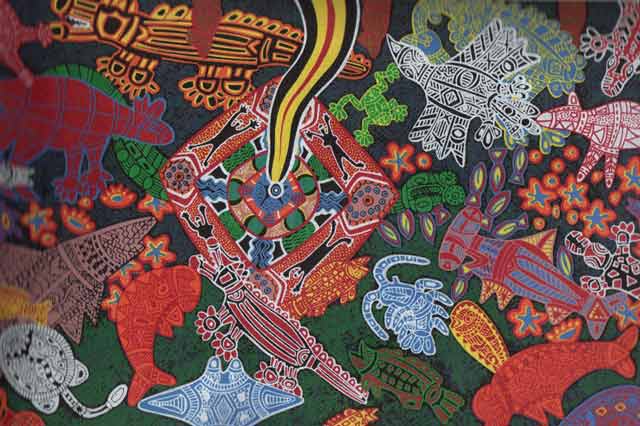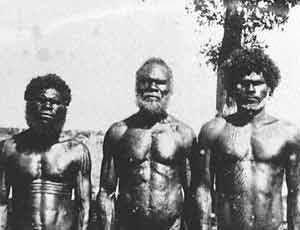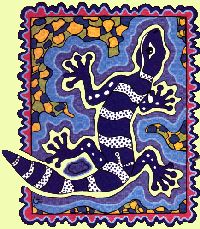Aborigine Literature
The name "aborigine" derives from theLatin, meaning "original inhabitants."
There are approx. 400,000 aborigines living in Australia.
Australian aborigines, native people of Australia who probably came from somewhere in Asia more than 40,000 years ago. In 2001 the population of aborigines and Torres Straits Islanders was 366,429, 1.9% of the Australian population as a whole and slightly more than the estimated aboriginal population of 350,000 at the time of European colonization in the late 18th cent. At that time, there were 500–600 distinct groups of aborigines speaking about 200 different languages or dialects (at least 50 of which are now extinct). Although culturally diverse, these groups were not political and economic entities and lacked class hierarchies and chiefs. They lived by hunting and gathering, and there was extensive intergroup trade throughout the continent.
The aborigines have an intricate classification system that defines kinship relations and regulates marriages. The Kariera, for example, are divided into hordes, or local groups of about 30 people, which are divided into four classes, or sections. Membership in a section determines ritual and territorial claims. In half of the hordes the men are divided among the Karimera and Burung sections; in the other half they are divided among the Palyeri and Banaka sections.
These sections are exogamous, and rules of marriage, descent, and residence determine how these sections interact: Karimera men must marry Palyeri women, and their children are Burung, and so on. Sons live in the same hordes as their fathers, so the composition of hordes alternates every generation. The complex system, by requiring each man to marry a woman from only one of the three possible sections, fosters a broad network of social relations and creates familial solidarity within the horde as a whole. Aborigines maintain elaborate systems of totemism (the belief that there is a genealogical relationship between people and species of plants or animals). They see the relationship between totemic plants and animals as a symbolic map of the relations between different people.
by
Stories
Aboriginal
Gods & Goddess's
Aborigine
Creation Myth
Amayworra
Another
Legend
At
Low Tide
Bahloo
The Moon And The Daens
Baiame
and Man
Baiame
and Marmoo
Baiame
and the First Man and Woman
Baiame
the Benefactor
Baiame's
Anger
Binndar
And The Googarhs
Bird
Legend
Boondi
Bootoolgah
The Crane And Goonur
The Kangaroo Rat, The Fire Makers
Bougoodoogahdah
The Rain Bird
Bunjil
is Swept from the Earth
Bunjil
the Creator #1
Bunjil
the Creator #2
Bunnyyarl
The Flies And Wurrunnunnah The Bees
Burra
Wurra - South Head
Deegeenboyah
the Soldier-bird
Deereeree
the Wagtail, and the Rainbow
Dinewan
the Emu, and Goomblegubbon the Bustard
Dinewan
the Emu, and Wahn the Crows
Eaglehawk
and Crow
Giant
Kangaroos
Goolahwilleel
the Topknot Pigeons
Gooloo
the Magpie, and the Wahroogah
GOOLOONOOBAH
Goomblegubbon,
Beeargah, and Ouyan
Goonur,
the Woman-Doctor
GURADJI
Gwai
Billa
How
Fire was Stolen from the Red-Crested Cockatoo
How
the Native Bear Lost His Tail
How
The Pistils Of The Waratah Became Firm
How
The Sky Was Lifted Up
How
the Stars Were Made
How
The Kangaroo Got A Long Tail,
And The Wombat A Flat Forehead
Koori
Legend
Of The Great Flood
Legend
Of The Sacred Bullroarer
Mayrah,
the Wind that Blows the Winter Away
Meamei
The Seven Sisters
Min-na-wee
Mirragan,
the Fisherman
Mist
And A Fringe Flower
South
Head - Burra Wurra
Star
Legend
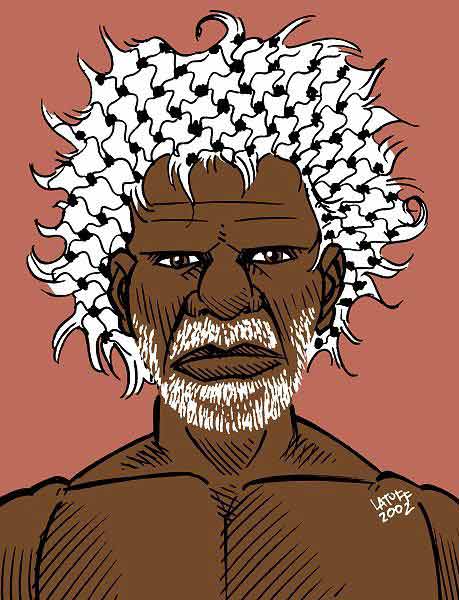
Worlds Oldest Inhabitants?
The word "aboriginal" means "the first" or
"earliest known". The word was first used in Italy and
Greece to describe people who lived there, natives or
old inhabitants, not newcomers, or invaders.
Australia may well be the home of the worlds first
people. Stone tools discovered in a quarry near Penrith,
New South Wales, in 1971 show that humans lived in
Australia at least twelve thousand years before they
appeared in Europe.
So far three early sites have been discovered in
Australia, the Penrith one being dated about forty-seven
thousand years old, a Western Australian site forty
thousand years old and another in Lake Mungo, New South
Wales, thirty-five thousand years old.
To put this in perspective, so that we can appreciate
the time scales, since the first fleet arrived in 1788
there have only been 8 generations of settlers. On the
other hand, there have been in excess of 18,500
generations of aboriginals!!!
Aboriginal
Studies Electronic Archive
(AIATSIS\ANU, Australia)
Aboriginal Studies WWW Virtual Library
Aboriginal
Programs Section
(Australian Nature Conservation Agency, Australia)
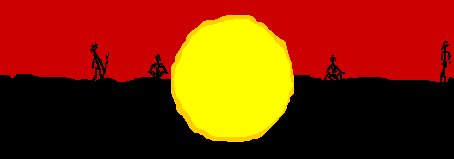
Picture, © Lynette F. Watters, based on the Australian
Aboriginal Flag
The colours represent the land (red), the sun
(yellow) & the people (black).
The
Aboriginal flag is divided horizontally into two
equal halves of black (top)
and red (bottom), with a yellow circle in the centre.
The black symbolises
Aboriginal people and the yellow represents the sun, the
constant renewer of life.
Red depicts the earth and also represents ochre, which
is used by Aboriginal People in ceremonies.
ANU-Aboriginal-Studies
(ANU, Australia)
Aboriginal
History Journal Archive
(ANU, Australia)
-
Australian National
University
Australian
Institute of Aboriginal
and Torres Strait Islander Studies
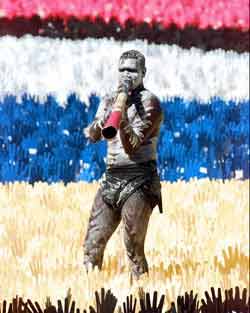 Djakapurra Munyarryun plays the didgeridoo |
||||
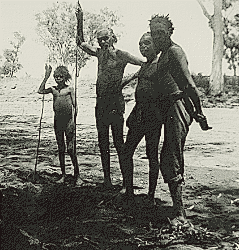 |
||||
Australian Indigenous Cultural Heritage
Australian Indigenous Peoples and the Law
Dreamtime
(An Aborigine Creation Story)
The "Dreamtime",
the mythological past, was the time when spirit
ancestors had travelled throughout the land, giving it
its physical form, and
setting down the rules to be followed by the
Aboriginals. Beings such as the
"Fertility Mother", the "Great Rainbow Snake", the
Djanggawul brothers
and sisters, survive in stories and ceremonies that
have been
passed down from generation to generation.
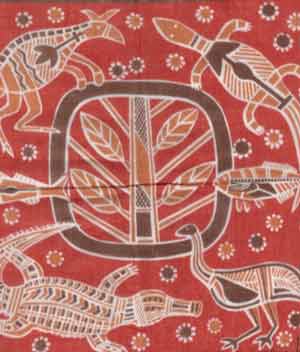
Aborigine Creation Story
as told by Aunty Beryl Carmichael
This is the creation story of Ngiyaampaa country, as well as the land belonging to Eaglehawk and Crow. Now long, long time ago of course, in the beginning, when there was no people, no trees, no plants whatever on this land, "Guthi-guthi", the spirit of our ancestral being, he lived up in the sky. So he came down and he wanted to create the special land for people and animals and birds to live in. So Guthi-guthi came down and he went on creating the land for the people - after he'd set the borders in place and the sacred sights, the birthing places of all the Dreamings, where all our Dreamings were to come out of.
Guthi-guthi put one foot on Gunderbooka Mountain and another one at Mount Grenfell. And he looked out over the land and he could see that the land was bare. There was no water in sight, there was nothing growing. So Guthi-guthi knew that trapped in a mountain - Mount Minara - the water serpent, Weowie, he was trapped in the mountain. So Guthi-guthi called out to him, "Weowie, Weowie", but because Weowie was trapped right in the middle of the mountain, he couldn't hear him. Guthi-guthi went back up into the sky and he called out once more, "Weowie", but once again Weowie didn't respond. So Guthi-guthi came down with a roar like thunder and banged on the mountain and the mountain split open.
Weowie the water serpent came out. And where the water serpent traveled he made waterholes and streams and depressions in the land. So once all that was finished, of course, Weowie went back into the mountain to live and that's where Weowie lives now, in Mount Minara. But then after that, they wanted another lot of water to come down from the north, throughout our country. Old Pundu, the Cod, it was his duty to drag and create the river known as the Darling River today. So Cod came out with Mudlark, his little mate, and they set off from the north and they created the big river. Flows right down, water flows right throughout our country, right into the sea now.
And of course, this country was also created, the first two tribes put in our country were Eaglehawk and Crow. And from these two tribes came many tribal people, many tribes, and we call them sub-groups today. So my people, the Ngiyaampaa people and the Barkandji further down are all sub-groups of Eaglehawk and Crow. So what I'm telling you the stories that were handed down to me all come from within this country.
History, Culture, and Conflict
Links to Aboriginal Resources
Myths and Legends of the Australian Aborigines
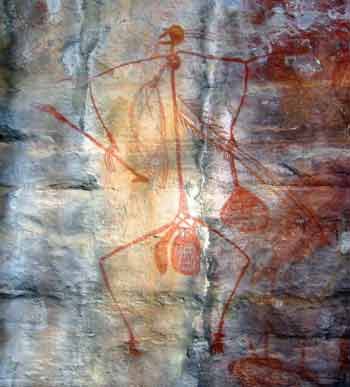
Rock painting at Ubirr in Kakadu National
Park
Use of Insects by Australian Aborigines
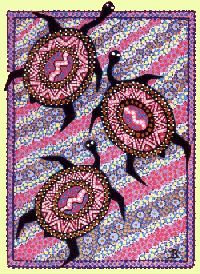
![]() Return to Indigenous Peoples' Literature
Return to Indigenous Peoples' Literature
Compiled by: Glenn
Welker
ghwelker@gmx.com
This page last updated 05/23/2019 02:27:56
This site has been accessed 10,000,000 times since February 8, 1996.

